| ID |
Date |
Author |
Category |
Subject |
Year |
|
32
|
Tue Feb 11 13:20:01 2020 |
Jan | Detectors | BaF2 - HV settings | |
with these HV values the 6 channels are roughly gain matched, such that the 7.83 MeV Po-decay is around channel 5000. |
| Attachment 1: BaF2_HV_settings.png
|

|
| Attachment 2: baf_bg_ch1.png
|
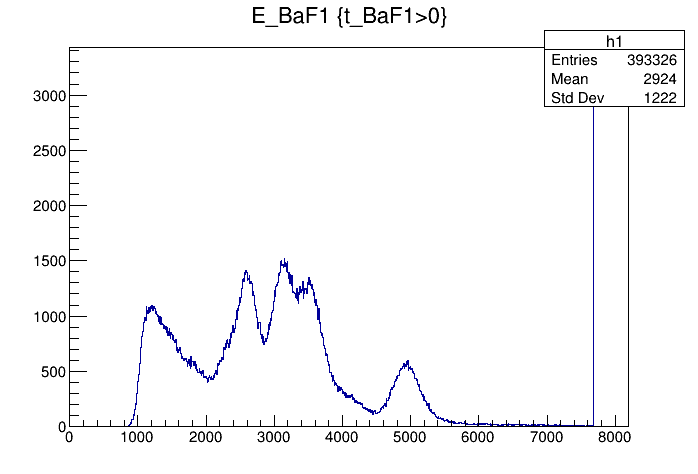
|
|
88
|
Fri Mar 20 22:26:42 2020 |
Jan | Detectors | BaF2 deactivated | |
BaF2 detectors are deactivated nor for the following runs. |
|
3
|
Wed Feb 6 10:04:23 2019 |
Laszlo Varga | Simulations | Background subtraction for 124Xe, 109In, 73As made by MOCADI | |
General remarks to the MOCADI simulations:
- scraper size vertically > (p,g) spot at the scraping position --> (p,g) can be separated by truncating the
backscattered Rutherford events in the energy.
- replacing the atomic masses to nuclear masses does not change significantly the absolute positions of the
(p,g) and the Rutherford. However, the (p,g) spot in the simulation seems bigger using the nuclear masses, than
in the 124Xe experiment with a factor ~1.6.
- going for lighter elements, the separation between (p,g) and Rutherford getting better, than slit can be
placed even more far from the beam in x (radial) direction. For 124Xe the minimal distance from the beam axis is
<4cm, for 73As it is <7.5cm.
- in the simulations the scraping is mostly until x=-inf. However, if the scraping is incomplete in x, we can end
up with underlying background events below the p,g peak (see the last slides)! The Rutherford cone gets bigger by
going down with A,Z. For 91Nb the minimal width of the scraper: x>6cm, for 73As x>7cm. Therefore, I suggest to
have a scraper width x=9cm. For the y, y=6cm should be safe.
- for lighter elements, the (p,g) spot size increases: in the simulation for 73As it reaches the detector size.
However, the (p,g) spot size might be overestimated, please read the 2. point.
|
| Attachment 1: template.pdf
|
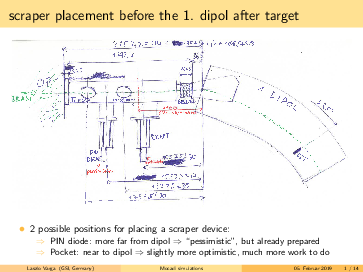

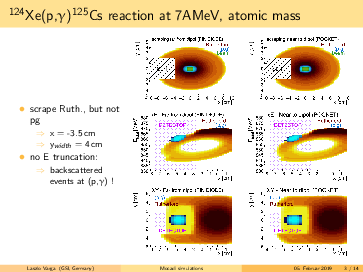
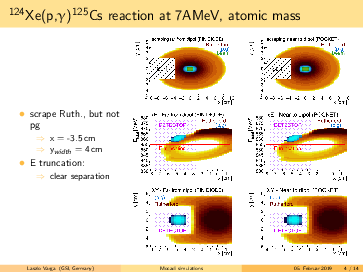
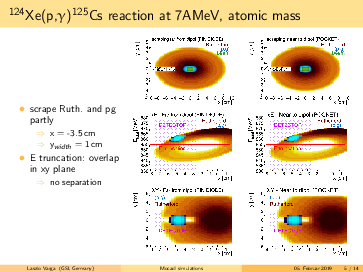

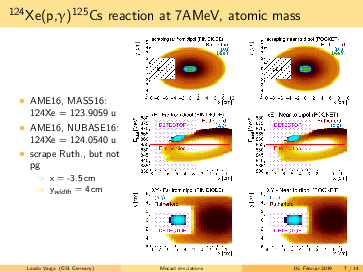
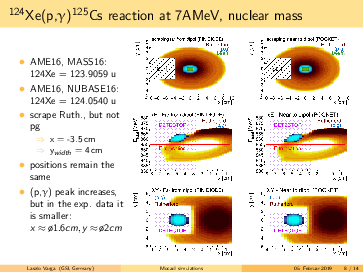
|
|
250
|
Mon Mar 23 14:23:01 2020 |
Pierre-Michel | DAQ | Backup recoil files | |
Recoil detector files backup to lxg1260:/data.local2/hillenbrand/Laszlo |
|
449
|
Tue May 25 17:12:59 2021 |
Robert/Shahab | Accelerator | Beam | 2021 |
Beam is back; It is now being optimized |
|
353
|
Wed May 19 19:47:14 2021 |
Yuri | General | Beam Halflife at 30 AMeV | 2021 |
|
| Attachment 1: 2021-05-19_17-35-00_tcl1032_lassie-monitor.png
|

|
|
572
|
Tue Jun 8 15:06:17 2021 |
Shahab | Analysis | Beam lifetime | 2021 |
measured beam lifetime after the second deceleration using parallel plate Schottky detector and the RSA5103 spectrum analyser. Analysis code can be found here:
https://github.com/xaratustrah/e127_scripts/
The plots here were produced using the script:
https://nbviewer.ipython.org/github/xaratustrah/e127_scripts/blob/main/lifetime_calculator.ipynb
UPDATE 2022-06-30:
Life times have been slightly corrected. Please see attachment.
Filename Start Frame Correct Lifetime [s] Mean [s]
pgamma_lifetime-2021.05.25.21.56.37.593_on.tiq 29500 1.43
pgamma_lifetime-2021.05.25.22.02.16.618_on.tiq 29500 1.55 1.49
pgamma_lifetime-2021.05.25.22.07.22.369_off.tiq 53500 1.75
pgamma_lifetime-2021.05.25.22.13.24.787_off.tiq 34900 1.89 1.82 |
| Attachment 1: pgamma_lifetime.001.png
|

|
| Attachment 2: pgamma_lifetime.002.png
|

|
|
350
|
Tue May 18 21:08:16 2021 |
ESR team | General | Beam stacking | 2021 |
Beam stacking. 3 pulses, stochastically cooled and stacked on an inner orbit |
| Attachment 1: 5B6943AF-DF56-4B0F-A77E-1E3C65B3B0C0.jpeg
|

|
| Attachment 2: B590F232-450A-4ACF-BBA4-DB31B7B35FDA.jpeg
|
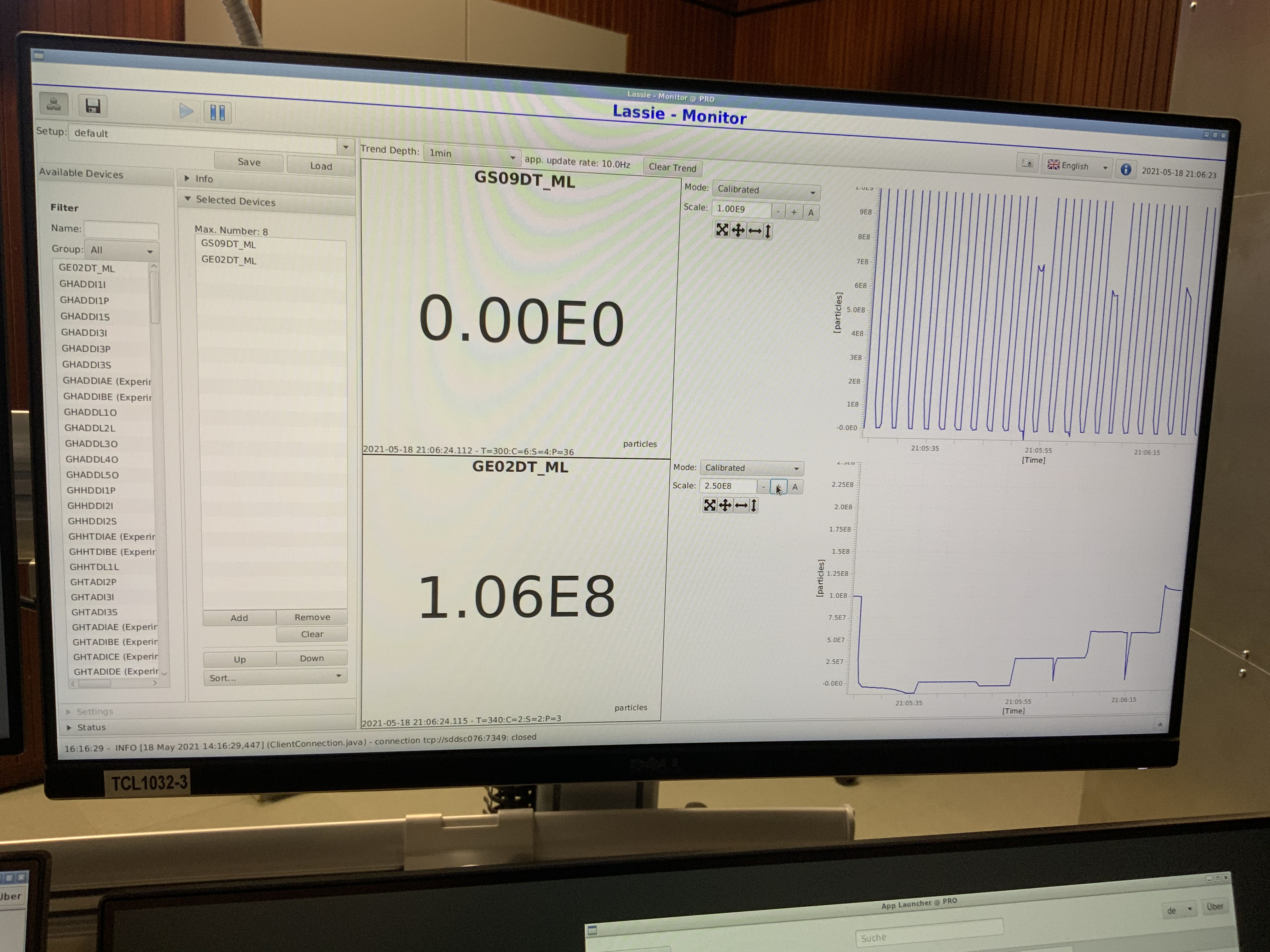
|
|
Draft
|
Fri Jun 28 14:06:28 2019 |
Jan | General | CAD of (p,g) setup | |
|
|
316
|
Thu May 6 11:03:46 2021 |
Jan Glorius | DAQ | Cabling Documentation | 2021 |
|
| Attachment 1: e127b_cabling_docu_06_05_2021_.pdf
|


|
| Attachment 2: e127b_2021_cabling_documentation.xlsx
|
|
346
|
Sun May 16 13:31:49 2021 |
Laszlo | DAQ | Cabling Documentation | 2021 |
Si HV and current was switched in the last documentation. |
| Attachment 1: e127b_2021_cabling_documentation.xlsx
|
|
471
|
Wed May 26 15:30:03 2021 |
Ragan, Thanassis | General | Changing the beam energy | 2021 |
The ESR team is changing the beam energy to 6 MeV/u. |
|
475
|
Wed May 26 19:08:17 2021 |
Ragan, Thanassis | General | Cooler down | 2021 |
We stopped data taking as the electron cooler is down. |
|
273
|
Wed Apr 8 20:06:10 2020 |
Laszlo | Calibration | Counts in the K-REC peaks | |
3 datasets were investigated:
-124Xe with Scraper (2. Xray calibration parameters needed)
-124Xe without Scraper (2. Xray calibration parameters needed)
-118Te with Scraper (1. Xray calibration parameters needed)
I looked all the 35°, 90° and 145° detector spectra:
-For both Xe measurements all 3 detector signal can be evaluated
-For Te beam one can see only in the 145° detector spectra the Kalpha and K-REC peaks (with high uncertainty). For the 35° probably the detector was simply not sensitive enough for such low beam intensities. For the 90° case, I am much surprised, the peaks supposed to be there the most prominent of all. In the spectra, I maybe can recognize a peak at ~27,8keV, but this is even in best case only the Kalpha peak. At the range of the expected K-REC (~40keV), there is a bit of increase in the background overlying the peak. This background increase is also in the background spectra. Also probably this twisted cables issue between 90° and 145° didn't help much. I think anyhow, that maybe this must have some noise related origin. I can remember that the cables (despite all of our and Uwe's tries) were not well grounded, the noise level was kind of floating.
In general, I would also remark that we can see some peaks >60keV in the background, but these luckily don't disturb us.
To evaluate the Xray spectra I used the following algorithm:
1, for each type of beams I used the list of event numbers in the next entry (to exclude "bad" events)
To get the Kalpha and K-REC and other peaks I used the condition trigger==1 (jet ON)
To get the background spectra, I used trigger==2 (Jet OFF). The background spectra is only used to see that there is no underlying peak structure below K-REC. To subtract count, the background histo was NOT in use.
2, While using a well-suiting number of bins, I plot the JetON and JetOFF histos.
By eye I choose the range of the K-REC peak and the range for the background fit on the JetON histo. Ofc range_bckgnd > range_peak.
Simultaneously, I check on the JetOFF histo that both, in the fit-range and in the peak-range, there should not be any peak structure visible.
3, For the fit-range in JetON histo, excluding the peak-range, I fit a linear function, m*x+b. For each bin in the fit-range I subtract m*bin_center+b value from the bin content. After the subtraction I check if I got spectra looking like a single peak sitting on a zero
line.
4, To get the K-REC counts, I sum together all the bin values for each bin of the subtracted histo within the peak-range. For the error calculation, I use Gaussian error prop. The uncertainty of the JetON histo counts = sqrt(counts). Also for the subtraction I make the
error like delta(m*bin_center+b)= sqrt(m*bin_center+b) instead using the uncertainty of the fit parameters. This second one wont make much sense, since the slope of the linear fit is usually close to 0 --> the errors grow unrealistically big.
Based on the algorithm above I got the following counts:
-124Xe with Scraper:
35°: 174 +/- 15
90°: 21299 +/- 150
145°: 2104 +/- 52
-124Xe without Scraper:
35°: 65 +/- 9
90°: 7792 +/- 91
145°: 728 +/- 31
-118Te_part1 with Scraper:
35°: -
90°: 427 +/- 40
145°: -
-118Te_part2 with Scraper:
35°: -
90°: 741 +/- 48
145°: -
-124Xe_lowRate with Scraper:
35°: -
90°: 2121 +/- 52
145°: - |
| Attachment 1: 124Xe_wScraper_full_spectra_labels_thick.png
|
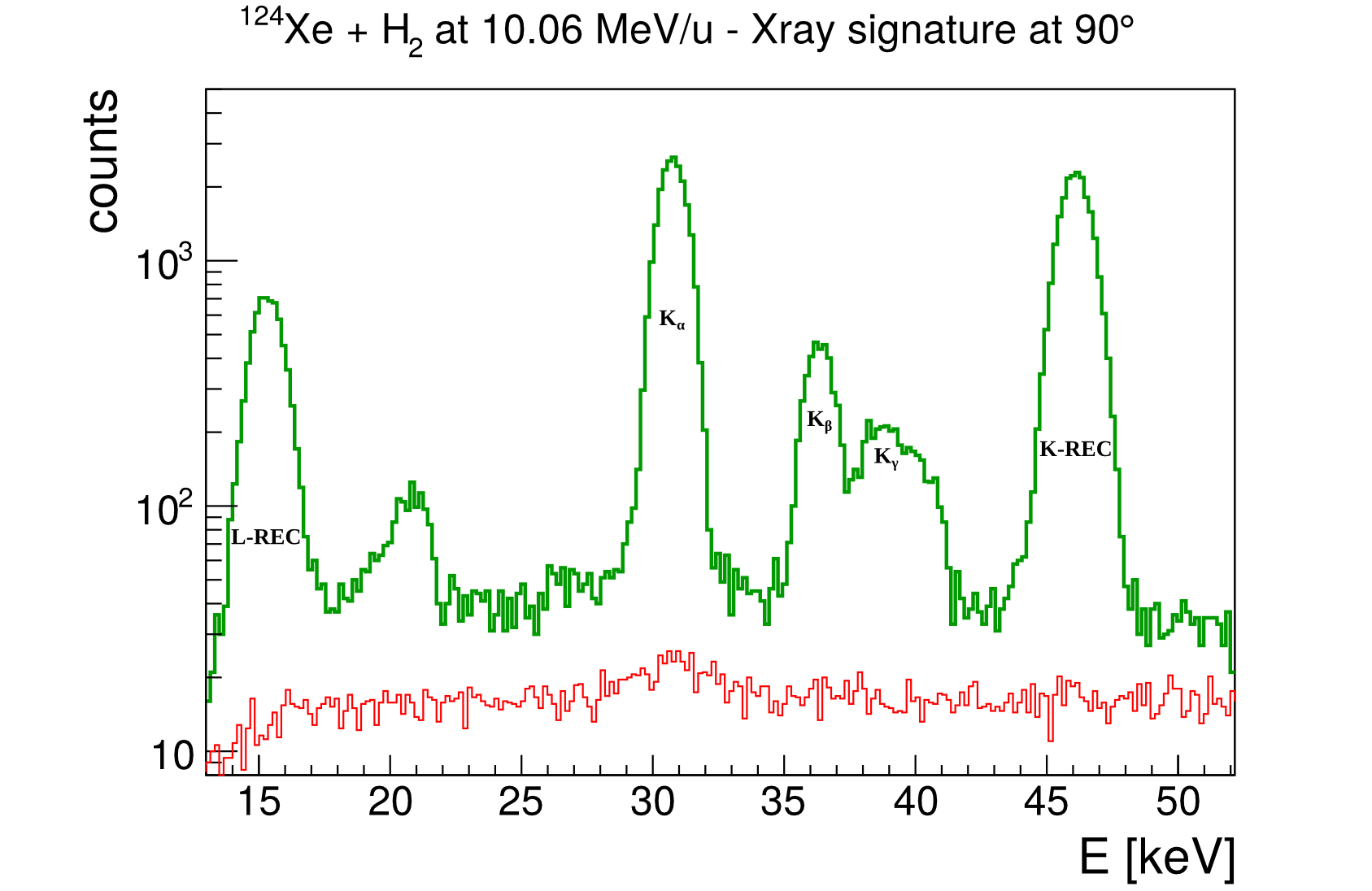
|
| Attachment 2: 124Xe_wScraper_90_backgnd.png
|
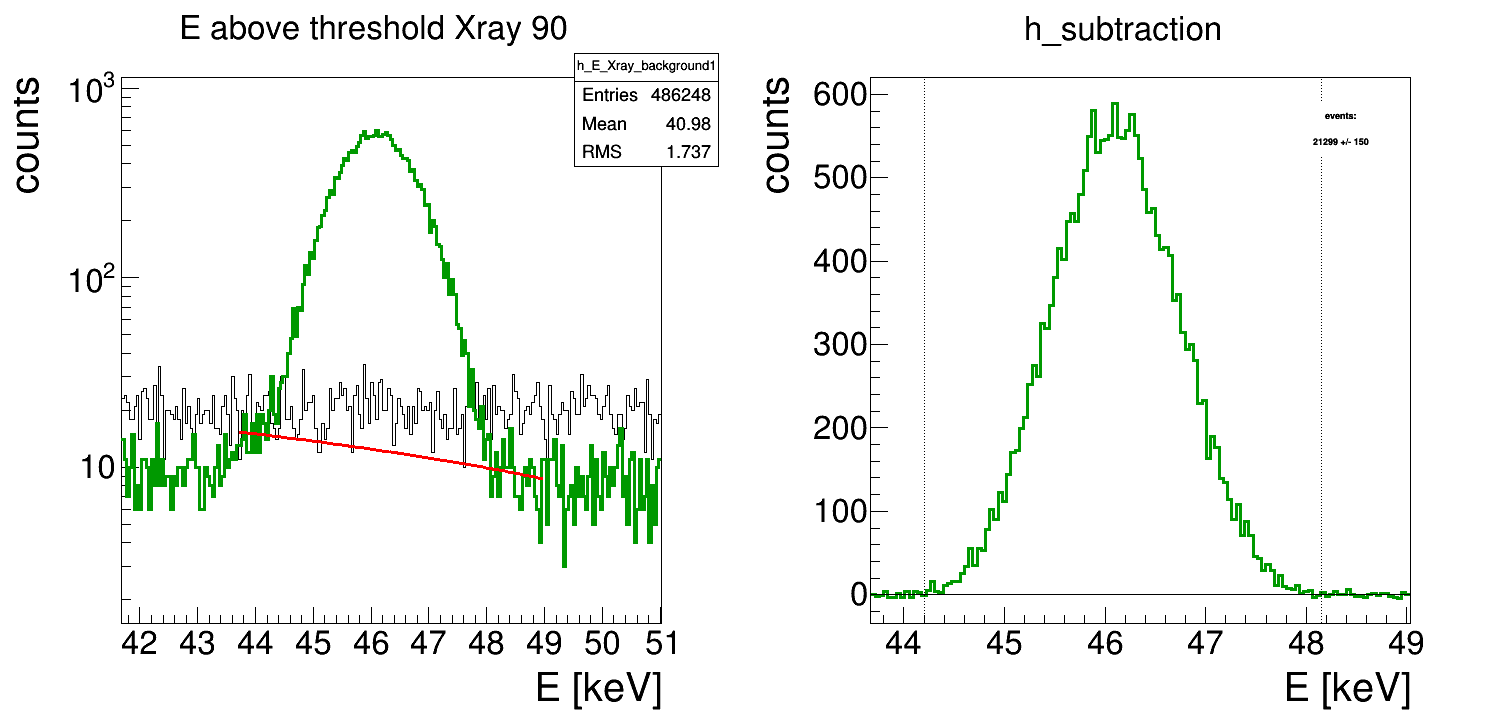
|
| Attachment 3: KREC-pics.zip
|
|
39
|
Wed Mar 11 09:08:21 2020 |
Jan | DAQ | DAQ & controls - OVERVIEW | |
For all DAQ & slow control buissines the user
litv-exp
is used with the password ViValasVegas1964
Here is a list of computers and devices we use for the current DAQ:
- r4l-58 - VME cpu (RIO)
our DAQ runs on this computer
access from lxg1275 via ssh litv-exp@r4l-58
the current DAQ directory is /esr/usr/litv-exp/2020_e127/r4l-58
from lxg-machines the DAQ dir can also be accessed via the mount point at /lynx/Lynx/esr/usr/litv-exp/2020_e127/r4l-58
- lxg1275 - main DAQ handler
used for communication with the DAQ and primary data writing/streaming
access from any lxg via ssh litv-exp@lxg1275
primary data folder: /data.local3/e127/lmd/
local backup folder: /data.local2/e127/lmd_backup/
- lxg1299 - online monitoring
used for the R3Broot online monitor server
access from any lxg via ssh litv-exp@lxg1299
online data: /data.local3/e127/online/
- atpnu004 - slow control
used for remote access to SpecAmps (MesyTec Shapers), Si-HV (caen) and picoscopes
access from any lxg via E127_nuc or ssh litv-exp@atpnuc004
screen sessions: mesy_ioc (shapers), caen_ioc (Si HV)
access screens by screen -x mesy_ioc or screen -x caen_ioc (exit with [Ctrl-a d])
access vnc session for picoscopes on any lxg: E127_vnc or vncviewer atpnuc004:1
- apraspi001 - slow control 2
used for remote access to the BaF HV crate
access from any lxg via ssh litv-exp@apraspi001
local access to HV control by telnet: telnet 169.254.93.160 1527
- lxg0188 - 1st backup node
used for direct backup of the written data (invoked automatically by stopping a run)
backup dir: /data.local2/E127_lmd/
- kronos.hpc.gsi.de - 2nd backup node
used for secondary backup of lmd-data on lxg0188 (chronjob every 4 hours)
backup dir: /lustre/ap/litv-exp/2020-03-17_E127_jglorius
List of commands and aliases
- E127_daq or /data.local1/e127/scripts/E127_start_gui.sh
this is the GUI to control the DAQ
available on lxg1275 only with litv-exp user
only one instance of this GUI can run at the same time!
- E127_unpack or /u/litv-exp/unpacker/unpackexps/e127/e127
this is the unpacker for the current DAQ
available on any lxg with litv-exp user
to unpack lmd-files to root-file: E127_unpack infile01.lmd infile02.lmd --ntuple=RAW,outfile.root
- E127_epics or epicsfind; medm -x /u/litv-exp/e127/medm/e127.adl
this is the GUI for slow control of Si HV and amplifiers (MesyTec Shapers)
available on any lxg with litv-exp user
- E127_rates or /u/litv-exp/e127/UDP/build_cc_x86_64-linux-gnu_4.9.2_debug/udp_reader --trig --rate
this is the UDP reader for detector and trigger rates
available on lxg1275 only with litv-exp user
|
|
71
|
Fri Mar 20 04:29:45 2020 |
Jan | DAQ | DAQ settings for the first night | |
|
| Attachment 1: e127.trlo
|
// -*- C++ -*-
/// ************************
// SETUP FILE FOR
// E127 experiment at ESR 2020
/// ************************
/////////////////////////////////
// ADC GATES
si_stretch = 2000 ns;
si_delay = 0 ns;
target_stretch = 15000 ns;
target_delay = 5000 ns; //5000 ns;
master_delay = 800 ns;
//////////////////////////////////
/// DOWNSCALING by 2^n
// n=5 >> 32
// n=6 >> 64
// n=7 >> 128
// n=8 >> 256
// n=9 >> 512
// TARGET ON
si_red = 0;
xray_red = 0;
baf_red = 5;//5;
// TARGET OFF
si_red_OFF = 0;
xray_red_OFF = 0;
baf_red_OFF = 0;//5;
//////////////////////////////////
// INPUTS
si_y = ECL_IN(1);
si_x = ECL_IN(2);
xray1 = ECL_IN(3);
xray2 = ECL_IN(4);
xray3 = ECL_IN(5);
baf = ECL_IN(6);
// = ECL_IN(7);
// = ECL_IN(8);
// = ECL_IN(9);
// = ECL_IN(10);
// = ECL_IN(11);
trafo = ECL_IN(12);
I_cool = ECL_IN(13);
U_cool = ECL_IN(14);
jet_S1 = ECL_IN(15);
// = ECL_IN(16);
jet_on = LEMO_IN(1);
jet_off = LEMO_IN(2);
//////////////////////////////
// OUTPUTS
si_gate = GATE_DELAY(1);
target_gate = GATE_DELAY(3);
qdc_gate = GATE_DELAY(4);
master_trig = GATE_DELAY(2);
pico_a = si_gate;
pico_b = target_gate;
//////////////////////////////
// CONSTANTS
long_gate = 2000 ns;
short_gate = 650 ns;
SECTION(all)
{
FRONT_LED(1) = TRIMI_TDT;
SERIAL_TSTAMP_IN = SERIAL_TSTAMP_OUT;
SERIAL_TSTAMP_LATCH = ACCEPT_PULSE;
slew_counter_add = 0x1000000;
fast_busy_len = 1000 ns;
DEADTIME_IN(1) = TRIMI_TDT;
/////////////////////////////////////////////////////////////
//PULSER
// mega_clock
period(4) = 1 us; // needed by UDP reader
// TRIGGER 11 >> interval for scaler readouts
period(1) = 1000 ms;
/////////////////////////////////////////////////////////////
// TRIGGERS
// coinc window length
accept_window_len = 1950 ns;
// THESE ARE THE VULOM INPUTS (det. triggers)
// STRETCH THE TRIGGER SIGNAL LONGER THAN THE accept_window_len
lmu_restart_mode(1) = LEAD_IF_INACT | GATE_ENABLE;
lmu_stretch(1) = long_gate; // front-back coinc gate
trig_stretch(1) = long_gate;
trig_stretch(2) = long_gate;
trig_stretch(3) = long_gate;
trig_stretch(9) = long_gate;
trig_stretch(10) = long_gate;
trig_stretch(11) = long_gate;
// SET UP DELAYS TO MATCH THE TRIGGER SIGNALS
//trig_delay(1) = 800 ns;
//trig_delay(2) = 800 ns;
//trig_delay(3) = 1120 ns;
//trig_delay(9) = 800 ns;
//trig_delay(10) = 800 ns;
//trig_delay(11) = 800 ns;
// STANDARD IS MODE_LEADING_EDGE (trigger on the falling edge)
// MODE_WHEN_PRESENT: check, if a signal is on (e.g. SPILL ON)
//trig_delay_mode(1) = MODE_THIS | MODE_LEADING_EDGE;
// DOWNSCALING FACTORS
// THIS IS FOR GENERATED TPATS (so downscale tpat number with red==2^n)
trig_red(1) = si_red;
trig_red(2) = xray_red;
trig_red(3) = baf_red;
trig_red(9) = si_red_OFF;
trig_red(10) = xray_red_OFF;
trig_red(11) = baf_red_OFF;
// ONLY NEEDED FOR MULTI-EVENT MODE / NO NEED NOW
//multi_trigger = 1;
////////////////////////////////////////////////////
// LMU SETUP
// THIS IS THE LOGIC MATRIX.
// TRIG_LMU_OUT(n) with 'n' being the tpat.
// TRIG_LMU_AUX 1
// silicon x/y OR
LMU_IN(1) = si_x;
LMU_IN(2) = si_y;
LMU_OUT(1) = LMU_IN(1) or LMU_IN(2);
TRIG_LMU_AUX(1) = LMU_OUT(1);
// TRIG_LMU_AUX 2
// xray OR
all_or_mask(2) = xray1 | xray2 | xray3;
LMU_IN(3) = ALL_OR(2);
LMU_OUT(2) = LMU_IN(3);
TRIG_LMU_AUX(2) = ALL_OR(2);
// TRIG_LMU 3
// BaF OR
LMU_IN(4) = baf;
LMU_OUT(4) = LMU_IN(4);
// BaF single
TRIG_LMU_AUX(3) = LMU_OUT(4);
//
TRIG_PENDING[11] = PULSER(1);
// TARGET_ON flag is TRIG_LMU_AUX(4)
// TARGET_ON_TRIGGERS
TRIG_LMU_OUT(1) = TRIG_LMU_AUX(1) and TRIG_LMU_AUX(4); //Si_ON
TRIG_LMU_OUT(2) = TRIG_LMU_AUX(2) and TRIG_LMU_AUX(4); //Xray_ON
TRIG_LMU_OUT(3) = TRIG_LMU_AUX(3) and TRIG_LMU_AUX(4); //BaF_ON
TRIG_LMU_OUT(4) = TRIG_LMU_AUX(1) and TRIG_LMU_AUX(3) and TRIG_LMU_AUX(4); //BaF+Si_ON
//TRIG_LMU_OUT(4) = ;
//TRIG_LMU_OUT(5) = ;
//TRIG_LMU_OUT(6) = ;
//TRIG_LMU_OUT(7) = ;
//TRIG_LMU_OUT(8) = ;
// TARGET_OFF_TRIGGERS
TRIG_LMU_OUT(9) = TRIG_LMU_AUX(1) and not TRIG_LMU_AUX(4); //Si_OFF
TRIG_LMU_OUT(10) = TRIG_LMU_AUX(2) and not TRIG_LMU_AUX(4); //Xray_OFF
TRIG_LMU_OUT(11) = TRIG_LMU_AUX(3) and not TRIG_LMU_AUX(4); //BaF_OFF
//TRIG_LMU_OUT(12) = ;
//TRIG_LMU_OUT(13) = ;
//TRIG_LMU_OUT(14) = ;
//TRIG_LMU_OUT(15) = ;
TRIG_LMU_OUT(16) =
si_x and si_y and
xray1 and xray2 and xray3 and baf and
trafo and I_cool and U_cool and jet_S1;
////////////////////////////////////////////////////////////
// TPAT SETUP
// THIS IS FOR MATCHING: TPAT -> MBS_TRIGGER
// tpat_trig(n) = m
// with n = tpat, m = MBS_trigger
// MBS trigger 1 = JET_ON
tpat_trig(1) = 1;
tpat_trig(2) = 1;
tpat_trig(3) = 1;
tpat_trig(4) = 1;
tpat_trig(5) = 1;
tpat_trig(6) = 1;
tpat_trig(7) = 1;
tpat_trig(8) = 1;
// MBS_trigger 2 = JET_OFF
tpat_trig(9) = 2;
tpat_trig(10) = 2;
tpat_trig(11) = 2;
tpat_trig(12) = 2;
tpat_trig(13) = 2;
tpat_trig(14) = 2;
tpat_trig(15) = 2;
tpat_trig(16) = 2;
// THIS IS FOR ENABLING THE SINGLE TPATS
// WITH A MASK, OR THE TPATS, OR RANGES WITH n : m.
tpat_enable = 1:4, 9:11;
//tpat_enable = 9:11;
//tpat_enable = mask 0xffff;
///////////////////////////////////////////////////////
// GATE & DELAY (MAX=4)
// SET UP THE GATES AND DELAYS
// Silicon ADC gate
// si_gate
GATE_DELAY(1) = MASTER_START;
delay(1) = si_delay;
stretch(1) = si_stretch;
// Masterstart/trigger
// master_trig
GATE_DELAY(2) = MASTER_START;
delay(2) = master_delay;
stretch(2) = 200 ns;
// Xray/BaF ADC gate
// target_gate
GATE_DELAY(3) = MASTER_START;
delay(3) = target_delay;
stretch(3) = target_stretch;
//unused
GATE_DELAY(4) = MASTER_START;
delay(4) = 0 ns;
stretch(4) = 200 ns;
////////////////////////////////////////////////////////
// SIGNAL I/O
// MAP THE LEMO & ECL OUTS
LEMO_OUT(1) = master_trig;
LEMO_OUT(2) = master_trig;
ECL_OUT(1) = si_gate;
ECL_OUT(2) = si_gate;
ECL_OUT(3) = target_gate;
ECL_OUT(4) = target_gate;
ECL_OUT(5) = qdc_gate;
ECL_OUT(6) = qdc_gate;
ECL_OUT(7) = master_trig;
ECL_OUT(8) = master_trig;
ECL_OUT(9) = pico_a;
//ECL_OUT(10) = ;
ECL_OUT(11) = pico_b;
//ECL_OUT(12) = ;
//ECL_OUT(13) = ;
//ECL_OUT(14) = ;
//ECL_OUT(15) = TRIG_LMU_OUT(1);
//ECL_OUT(16) = LMU_OUT(1);
/* Generates internal BOS and EOS. */
/*
spill_period_duration = 20000000 us;
spill_on_duration = 12000000 us;
SECTION(bos_eos_generate)
{
period(3) = spill_period_duration;
GATE_DELAY(3) = PULSER(3);
stretch(3) = spill_on_duration;
delay(3) = 0 ns;
TRIG_PENDING[12] = PULSER(3);
GATE_DELAY(4) = GATE_DELAY(3);
stretch(4) = 50 ns;
delay(4) = 0 ns;
restart_mode(4) = TRAILING_EDGE;
TRIG_PENDING[13] = GATE_DELAY(4);
TRIG_LMU_AUX(3) = GATE_DELAY(3);
}
*/
/* Listens to BOS and EOS from the accelerator. */
////////////////////////////////////////////////////
// JET ON/OFF TRIGGER SETUP
EDGE_GATE_START(1) = jet_on;
TRIG_PENDING[12] = jet_on;
EDGE_GATE_STOP(1) = jet_off;
TRIG_PENDING[13] = jet_off;
TRIG_LMU_AUX(4) = EDGE_GATE(1);
}
|
| Attachment 2: main.cfg
|
#log_level = verbose
CRATE("Master")
{
event_max = 1
BARRIER
MESYTEC_MADC32(0x00A10000) {
nim_busy = gate0
range = 8 V
resolution=8
hires=true
}
BARRIER
MESYTEC_MADC32(0x00A20000) {
nim_busy = gate0
range = 4 V
resolution=8
hires=true
}
#BARRIER
#CAEN_V965 (0x00B10000) {
# channel_enable = 0..11
#}
BARRIER
CAEN_V775 (0x00C10000) {
common_start = false
time_range = 1200 ns
suppress_invalid = true
suppress_over_range = true
}
BARRIER
CAEN_V775 (0x00C20000) {
common_start = false
time_range = 1200 ns
suppress_invalid = true
suppress_over_range = true
}
BARRIER
#CAEN_V830 (0x00E10000) {
# resolution = 32
# }
#BARRIER
#CAEN_V830 (0x00E20000) {
# resolution = 32
#}
#BARRIER
GROUP("Timetamp")
GSI_VULOM(0x05000000) {
timestamp = true
}
}
|
| Attachment 3: r3bfuser.cfg
|
[r3bfuser]
# White Rabbit ID, =0 -> don't write MBS TO timestamp sub-event.
# Subevent 10/1: WR subsystem ID + timestamp
# wr_id = 0x100
# Save LOS/ROLU scalers/samplers every n:th spill, =0 -> don't read.
# Subevent 38/3800: ECL_IN scalers + pileup histogram
# Subevent 39/3900: trloii sampler data
do_beam_scalers = 1
# Save spill structure with 1/10s sized bins.
# do_spill_struct = 10
# Handle spill triggers 10..13 specially, >0 -> keep-alive grace period in s.
# period put to ~2 weeks, to enable long-term vulom scalers with targetOFF
do_spill_triggers = 1000000
# Save TPAT sub-event for every event
# Subevent 36/3600: trlo multi-event TPAT information
do_tpat = 1
# Save LMU scalers on spill triggers (10..13).
# Subevent 37/3700: lmu scalers (input, before / after DT & after reduction)
do_lmu_scalers = 1
# Send beam samplers and LMU scalers via UDP, !="" -> target host.
do_udp = "lxg1275.gsi.de"
|
| Attachment 4: setting.1584673412
|
1584673412
Fri Mar 20 04:03:32 CET 2020
e127pi:mrcc:mscf1:getGainCommon 1
e127pi:mrcc:mscf1:getShapingTimeCommon 1
e127pi:mrcc:mscf1:getThresholdCommon 2
e127pi:mrcc:mscf1:getPzCommon 100
e127pi:mrcc:mscf2:getGainCommon 1
e127pi:mrcc:mscf2:getShapingTimeCommon 1
e127pi:mrcc:mscf2:getThresholdCommon 2
e127pi:mrcc:mscf2:getPzCommon 100
e127pi:mrcc:mscf3:getGainCommon 6
e127pi:mrcc:mscf3:getShapingTimeCommon 3
e127pi:mrcc:mscf3:getThresholdCommon 1
e127pi:mrcc:mscf3:getPzCommon 38
e127pi:mrcc:mscf1:getGain1 4
e127pi:mrcc:mscf1:getGain2 4
e127pi:mrcc:mscf1:getGain3 4
e127pi:mrcc:mscf1:getGain4 4
e127pi:mrcc:mscf1:getShapingTime1 1
e127pi:mrcc:mscf1:getShapingTime2 1
e127pi:mrcc:mscf1:getShapingTime3 1
e127pi:mrcc:mscf1:getShapingTime4 1
e127pi:mrcc:mscf2:getGain1 9
e127pi:mrcc:mscf2:getGain2 4
e127pi:mrcc:mscf2:getGain3 8
e127pi:mrcc:mscf2:getGain4 8
e127pi:mrcc:mscf2:getShapingTime1 2
e127pi:mrcc:mscf2:getShapingTime2 2
e127pi:mrcc:mscf2:getShapingTime3 2
e127pi:mrcc:mscf2:getShapingTime4 2
e127pi:mrcc:mscf3:getGain1 15
e127pi:mrcc:mscf3:getGain2 0
e127pi:mrcc:mscf3:getGain3 15
e127pi:mrcc:mscf3:getGain4 10
e127pi:mrcc:mscf3:getShapingTime1 0
e127pi:mrcc:mscf3:getShapingTime2 0
e127pi:mrcc:mscf3:getShapingTime3 1
e127pi:mrcc:mscf3:getShapingTime4 1
e127pi:mrcc:mscf1:getThreshold1 4
e127pi:mrcc:mscf1:getThreshold2 4
e127pi:mrcc:mscf1:getThreshold3 4
e127pi:mrcc:mscf1:getThreshold4 1
e127pi:mrcc:mscf1:getThreshold5 4
e127pi:mrcc:mscf1:getThreshold6 4
e127pi:mrcc:mscf1:getThreshold7 4
e127pi:mrcc:mscf1:getThreshold8 4
e127pi:mrcc:mscf1:getThreshold9 4
e127pi:mrcc:mscf1:getThreshold10 5
e127pi:mrcc:mscf1:getThreshold11 5
e127pi:mrcc:mscf1:getThreshold12 5
e127pi:mrcc:mscf1:getThreshold13 3
e127pi:mrcc:mscf1:getThreshold14 4
e127pi:mrcc:mscf1:getThreshold15 5
e127pi:mrcc:mscf1:getThreshold16 5
e127pi:mrcc:mscf1:getPz1 128
e127pi:mrcc:mscf1:getPz2 128
e127pi:mrcc:mscf1:getPz3 128
e127pi:mrcc:mscf1:getPz4 128
e127pi:mrcc:mscf1:getPz5 128
e127pi:mrcc:mscf1:getPz6 128
e127pi:mrcc:mscf1:getPz7 128
e127pi:mrcc:mscf1:getPz8 128
e127pi:mrcc:mscf1:getPz9 128
e127pi:mrcc:mscf1:getPz10 128
e127pi:mrcc:mscf1:getPz11 128
e127pi:mrcc:mscf1:getPz12 128
e127pi:mrcc:mscf1:getPz13 128
e127pi:mrcc:mscf1:getPz14 128
e127pi:mrcc:mscf1:getPz15 128
e127pi:mrcc:mscf1:getPz16 128
e127pi:mrcc:mscf2:getThreshold1 255
e127pi:mrcc:mscf2:getThreshold2 255
e127pi:mrcc:mscf2:getThreshold3 0
e127pi:mrcc:mscf2:getThreshold4 255
e127pi:mrcc:mscf2:getThreshold5 255
e127pi:mrcc:mscf2:getThreshold6 255
e127pi:mrcc:mscf2:getThreshold7 255
e127pi:mrcc:mscf2:getThreshold8 255
e127pi:mrcc:mscf2:getThreshold9 255
e127pi:mrcc:mscf2:getThreshold10 255
e127pi:mrcc:mscf2:getThreshold11 0
e127pi:mrcc:mscf2:getThreshold12 255
e127pi:mrcc:mscf2:getThreshold13 255
e127pi:mrcc:mscf2:getThreshold14 255
e127pi:mrcc:mscf2:getThreshold15 0
e127pi:mrcc:mscf2:getThreshold16 255
e127pi:mrcc:mscf2:getPz1 128
e127pi:mrcc:mscf2:getPz2 128
e127pi:mrcc:mscf2:getPz3 87
e127pi:mrcc:mscf2:getPz4 255
e127pi:mrcc:mscf2:getPz5 255
e127pi:mrcc:mscf2:getPz6 255
e127pi:mrcc:mscf2:getPz7 255
e127pi:mrcc:mscf2:getPz8 255
e127pi:mrcc:mscf2:getPz9 255
e127pi:mrcc:mscf2:getPz10 255
e127pi:mrcc:mscf2:getPz11 85
e127pi:mrcc:mscf2:getPz12 255
e127pi:mrcc:mscf2:getPz13 255
e127pi:mrcc:mscf2:getPz14 255
e127pi:mrcc:mscf2:getPz15 85
e127pi:mrcc:mscf2:getPz16 255
e127pi:mrcc:mscf3:getThreshold1 5
e127pi:mrcc:mscf3:getThreshold2 255
e127pi:mrcc:mscf3:getThreshold3 255
e127pi:mrcc:mscf3:getThreshold4 255
e127pi:mrcc:mscf3:getThreshold5 255
e127pi:mrcc:mscf3:getThreshold6 255
e127pi:mrcc:mscf3:getThreshold7 255
e127pi:mrcc:mscf3:getThreshold8 255
e127pi:mrcc:mscf3:getThreshold9 255
e127pi:mrcc:mscf3:getThreshold10 255
e127pi:mrcc:mscf3:getThreshold11 255
e127pi:mrcc:mscf3:getThreshold12 255
e127pi:mrcc:mscf3:getThreshold13 255
e127pi:mrcc:mscf3:getThreshold14 255
e127pi:mrcc:mscf3:getThreshold15 255
e127pi:mrcc:mscf3:getThreshold16 255
e127pi:mrcc:mscf3:getPz1 128
e127pi:mrcc:mscf3:getPz2 128
e127pi:mrcc:mscf3:getPz3 128
e127pi:mrcc:mscf3:getPz4 128
e127pi:mrcc:mscf3:getPz5 128
e127pi:mrcc:mscf3:getPz6 128
e127pi:mrcc:mscf3:getPz7 128
e127pi:mrcc:mscf3:getPz8 128
e127pi:mrcc:mscf3:getPz9 128
e127pi:mrcc:mscf3:getPz10 128
e127pi:mrcc:mscf3:getPz11 128
e127pi:mrcc:mscf3:getPz12 128
e127pi:mrcc:mscf3:getPz13 128
e127pi:mrcc:mscf3:getPz14 128
e127pi:mrcc:mscf3:getPz15 128
e127pi:mrcc:mscf3:getPz16 128
e127pi:mrcc:mscf1:getSingleChMode 0
e127pi:mrcc:mscf2:getSingleChMode 0
e127pi:mrcc:mscf3:getSingleChMode 0
e127pi:mrcc:mscf1:getRcMode 1
e127pi:mrcc:mscf2:getRcMode 1
e127pi:mrcc:mscf3:getRcMode 1
e127pi:mrcc:mscf1:getAutoPZ 0
e127pi:mrcc:mscf2:getAutoPZ 0
e127pi:mrcc:mscf3:getAutoPZ 1
e127pi:mrcc:mscf1:getMultiplicityHi 8
e127pi:mrcc:mscf2:getMultiplicityHi 8
e127pi:mrcc:mscf3:getMultiplicityHi 8
e127pi:mrcc:mscf1:getMultiplicityLo 4
e127pi:mrcc:mscf2:getMultiplicityLo 4
e127pi:mrcc:mscf3:getMultiplicityLo 1
e127pi:mrcc:mscf1:getSumTrgThresh 10
e127pi:mrcc:mscf2:getSumTrgThresh 10
e127pi:mrcc:mscf3:getSumTrgThresh 100
e127pi:mrcc:mscf1:getBlrOn 1
e127pi:mrcc:mscf2:getBlrOn 1
e127pi:mrcc:mscf3:getBlrOn 0
e127pi:mrcc:mscf1:getCoincTime 128
e127pi:mrcc:mscf2:getCoincTime 128
e127pi:mrcc:mscf3:getCoincTime 100
e127pi:mrcc:mscf1:getThreshOffset 100
e127pi:mrcc:mscf2:getThreshOffset 100
e127pi:mrcc:mscf3:getThreshOffset 1
e127pi:mrcc:mscf1:getShaperOffset 100
e127pi:mrcc:mscf2:getShaperOffset 100
e127pi:mrcc:mscf3:getShaperOffset 100
e127pi:mrcc:mscf1:getBlrThresh 25
e127pi:mrcc:mscf2:getBlrThresh 25
e127pi:mrcc:mscf3:getBlrThresh 10
e127pi:mrcc:mscf1:getECLDelay 0
e127pi:mrcc:mscf2:getECLDelay 0
e127pi:mrcc:mscf3:getECLDelay 0
|
|
12
|
Fri Jun 7 15:57:41 2019 |
Jan | DAQ | DAQ with & without MDPP-16 | |
The DAQ located in
../esrdaq_2018/r4l-58/
currently includes the readout of
MADC
Caen 775 TDC
Caen 830 Scaler
MDPP-16
../esrdaq_2018/r4l-58_rewind/
is without the MDPP-16:
MADC
Caen 775 TDC
Caen 830 Scaler |
|
26
|
Wed Oct 23 15:35:29 2019 |
Jan | DAQ | DAQ with & without MDPP-16 | |
the DAQ located in
../esrdaq_2018/r4l-58_dev/
currently includes
2x MADC
2x Caen V775 TDC
2x Caen V830 Scaler
> The DAQ located in
>
> ../esrdaq_2018/r4l-58/
> currently includes the readout of
> MADC
> Caen 775 TDC
> Caen 830 Scaler
> MDPP-16
>
> ../esrdaq_2018/r4l-58_rewind/
> is without the MDPP-16:
> MADC
> Caen 775 TDC
> Caen 830 Scaler |
|
386
|
Sat May 22 14:53:34 2021 |
Beatriz et al. | General | DSSD Movement | 2021 |
DSSSD moved to the most in position in order to try to scrape the beam with the scraper. |
|
286
|
Tue Nov 24 15:35:49 2020 |
Jan | Calibration | DSSD X/Y channel mapping | 2021 |
During the detector test test measurements with alpha source the allocation of the 16 X- and 16 Y-channels has been checked.
For the following final allocation, it is always assumed that the (horizontal) y-strips are placed to face the beam directly, while the (vertical) x-strips are on the backside.
Now, all cables from the preamp to the ADC/TDCs are either labeled BLACK (= X-strips, pos. signals) or labeled RED (= Y-strips, neg. signals). These red or black connections should be kept consistently in order to ensure a well known orientation of the DSSD during the experiment. The test run Si2_run006.lmd was taken with this final assignment and serves as reference.
BLACK LABEL > X1 to X16 > pos. MSCF > ADC/TDC ch 0-15 > 50 Ohm resistor at preamps HV-input
RED LABEL > Y1 to Y16 > neg. MSCF > ADC/TDC ch 16-31 > neg. bias voltage at preamps HV-input
Additionally, the RED label indicates the section on the preamp to which negative bias voltage should be applied. |